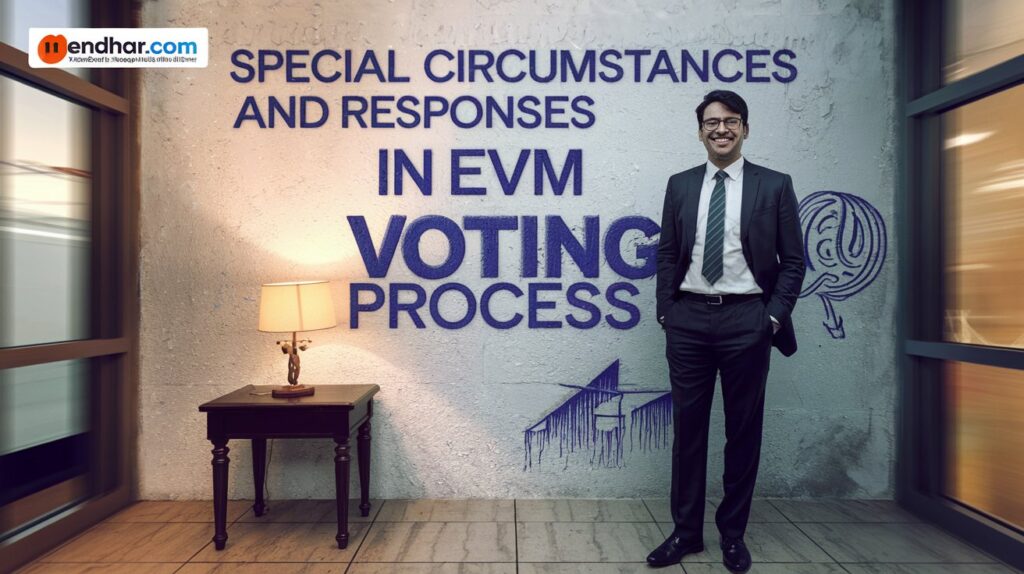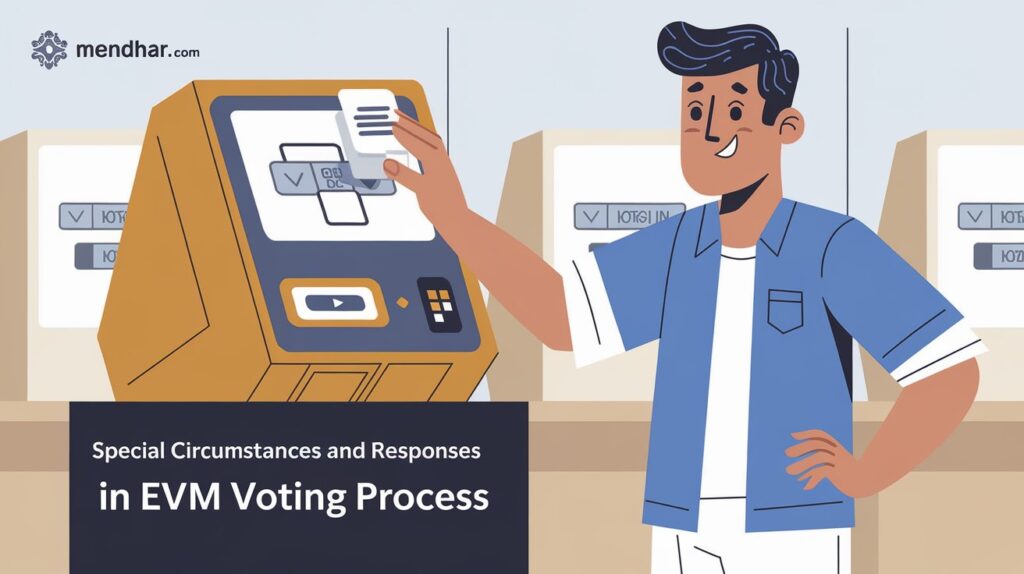The Election Voting process, especially in large democratic countries like India, encounters unique situations that require special attention and responses. During elections, certain circumstances, such as complaints about incorrect VVPAT paper slips, defective EVMs, absentee voters, and more, demand immediate actions from election officials. This blog provides a detailed overview of such instances and the responses required from presiding officers, polling agents, and election staff.

Table of Contents
ToggleVoter Complaint about Wrong Print on VVPAT Paper Slip
One significant issue that may arise during elections is when a voter complains about an incorrect print on the VVPAT (Voter Verifiable Paper Audit Trail) paper slip against the button pressed on the Ballot Unit (BU). As per Rule 49MA, a structured procedure follows:
- The voter is required to sign a written declaration.
- The presiding officer must make a second entry related to the elector in Form 17A.
- A test vote is allowed in the presence of the presiding officer and polling agents to observe the paper slip.
- If the allegation is found to be true, polling is stopped, and the returning officer (RO) is informed.
- If the allegation is false, the details, including the serial number and candidate name for whom the test vote was cast, are recorded in Form 17A.
- The voter’s signature or thumb impression is taken as confirmation.
- All test vote entries are made in Part I of Form 17C.
By following these steps, election authorities ensure that voter complaints about the VVPAT paper slip are addressed transparently and systematically, protecting the integrity of the electoral process.
Defective EVM/VVPAT and Corrective Measures
Election officials might also face technical malfunctions in the Control Unit (CU), Ballot Unit (BU), or VVPAT. In such cases, immediate corrective steps are essential to ensure the voting process continues smoothly:
- If the CU or BU does not function properly, the entire set of CU, BU, and VVPAT must be replaced.
- A mock poll is conducted with one vote for each candidate, including the NOTA (None of the Above) option.
- The procedure of the mock poll is followed diligently to ensure accuracy.
This rapid response ensures minimal disruption during the election and prevents any bias or undue advantage to any candidate. Handling defective EVMs or VVPATs is critical to maintaining voter confidence in the system.
Voter from Absentee, Shifted, and Dead (ASD) List
In every election, a list of voters who are Absentee, Shifted, or Dead is prepared by the ERO/RO based on field information. Voters from the ASD list can still participate in the voting process but must adhere to stricter verification measures:
- The voter must produce their EPIC (Electoral Photo Identity Card) or another permitted photo ID.
- The presiding officer personally verifies the identity of the voter.
- In addition to a signature, the voter’s thumb impression is obtained in the Register of Voters (Form 17A).
- A record of voters from the ASD list is maintained, and the presiding officer issues a certificate at the end of polling.
These steps ensure that only legitimate voters from the ASD list participate, minimizing the chances of fraud or impersonation in the election process.

Voter with Unofficial Identity Slip
Another situation arises when a contesting candidate or their agent provides a voter with an unofficial identity slip. This unofficial slip may contain the candidate’s name, party, or symbol. The response to such circumstances includes:
- The concerned polling agent is instructed to cease the violation.
- For illiterate voters, the First Polling Officer reads the voter’s serial number and requests the voter to confirm their identity.
- In cases of impersonation, the offender is handed over to the police, as outlined in Annexure-19.
For women electors, particularly those who are pardanashin (burqa-clad), a female polling officer handles the verification process in a separate enclosure. This practice ensures that the voting process is fair and transparent, without undue influence or manipulation by contesting candidates.
Challenged Votes
In certain cases, a voter’s identity may be challenged by polling agents. In such instances, a summary inquiry is conducted by the presiding officer:
- If the challenge is not established, the elector is allowed to vote.
- If the challenge is proven, the voter is debarred from voting and handed over to the police with a written complaint.
This process upholds the integrity of the electoral system by preventing unqualified voters from participating, thus protecting the rights of genuine voters.
Declaration of Elector about Age
If the presiding officer believes that a voter is below the qualifying age, they must satisfy themselves about the elector’s identity and age. The steps involved are:
- The voter must sign a declaration stating their age as of the reference date (1st January, 1st April, 1st July, or 1st October).
- The voter is informed about the penal provisions for providing false information.
- A list of voters from whom such declarations are obtained is prepared in Annexure 9, Part I & II.
These measures ensure that underage individuals do not participate in the election, maintaining the fairness of the process.
Electors Deciding Not to Vote
An elector who has already signed Form 17A but later decides not to vote cannot be forced to do so. The following steps are taken:
- A remark stating “Refused to Vote” is made in the Register of Voters and signed by the presiding officer.
- In Part I of Form 17C, under Rule 49-O, the entry is made as “Left without voting” or “Refused to vote.”
This allows voters to opt out of voting while ensuring that their decision is properly documented, respecting their rights as citizens.
Tendered Votes
Lastly, there may be instances where a voter arrives to vote, only to find that someone else has already cast a vote in their name. In such cases, the presiding officer allows the voter to cast a tendered vote:
- The presiding officer confirms the voter’s identity.
- A tendered ballot paper is issued, and the vote is recorded manually, not by EVM.
- The account of tendered votes is recorded in Form 17B.
This ensures that every legitimate voter gets a chance to cast their vote, even if an error has occurred.
Conclusion
The election process is a cornerstone of democracy, and addressing these special circumstances is crucial for maintaining its integrity. From handling defective EVMs and VVPAT slips to managing tendered votes and voters from the ASD list, the roles and responsibilities of election officials ensure that the process remains fair and transparent. Understanding these procedures helps reinforce trust in the electoral system, ensuring every voter’s voice is heard.
FAQ about Special Circumstances and Responses in EVM Voting Process
1. What should a voter do if the VVPAT paper slip shows the wrong candidate after pressing the button?
If a voter notices that the VVPAT paper slip shows the wrong candidate, they should immediately inform the presiding officer. Under Rule 49MA, the voter will be asked to sign a written declaration and cast a test vote in the presence of polling agents. If the complaint is verified, polling will be stopped, and the matter will be reported to the returning officer.
2. What happens if the EVM or VVPAT becomes defective during polling?
If the Control Unit (CU), Ballot Unit (BU), or VVPAT becomes defective, the entire set of EVM equipment will be replaced. A mock poll will be conducted to ensure the new equipment works correctly before the polling resumes.
3. How is a voter from the ASD (Absentee, Shifted, Dead) list allowed to vote?
Voters from the ASD list must produce a valid EPIC or another permitted photo ID. Their identity is personally verified by the presiding officer, and both a thumb impression and signature are taken in the Register of Voters (Form 17A).
4. What is a tendered vote, and when is it used?
A tendered vote is cast when a voter finds that someone else has already voted in their name. In this case, after verifying the voter’s identity, the presiding officer issues a tendered ballot paper for the vote to be cast manually, not by EVM.
5. What should be done if a voter decides not to cast a vote after their details are recorded?
If a voter decides not to cast a vote after signing Form 17A, a remark stating “Refused to Vote” is added to the Register of Voters. This refusal is also noted in Part I of Form 17C, ensuring that their decision is properly documented



Good information
Wel done
Good job sir